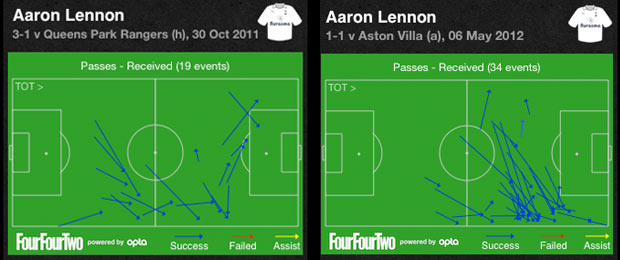Aaron Lennon scored his first goal of the season for Spurs against Aston Villa at the weekend.
The diminutive winger was in and out of the line-up last season and his future looked uncertain when Andre Villas-Boas took charge with his liking for a 4-3-3.
The Portuguese’s system requires the wide forwards to play higher up the pitch than the conventional wingers used by Harry Redknapp.
Villas-Boas has started Aaron Lennon in every Premier League match so far though, using him to stretch opposition defences with his pace. His goal against Villa was hopefully the first of many and back in 2009, Spurs’ wingman targeted scoring 10 goals a season.
“I think I’ve got goals in me and I’ve set my goal at 10. That’s definitely one of the things I’ve been trying to improve in my game – getting more goals.”
That’s a pretty lofty target for a player whose best in a season was five back in the 2008-09 campaign.
Last season he registered four strikes from a shot at goal every 91 minutes; this term he is actually shooting less, with a shot at goal every 108 minutes on pitch.
So will Aaron Lennon reach his target of 10? Probably not, but he may eclipse his best total of 9 assists in the Premier League due to his new role under Andre Villas-Boas.
Aaron Lennon HR to AVB
Harry Redknapp used Aaron Lennon as a conventional winger in his 4-4-1-1 system. He would receive the ball to feet in front of the opposition full back, then look to gain pace and beat him with a dribble before crossing.
If we look at a couple of games from last season, Aaron Lennon receives the ball wide on the right, from passes to him that are above the 18-yard box. From here he can attack the full back with his speed and dribbling.

Andre Villas-Boas likes his 4-3-3 to combine a wide forward who cuts in to the middle with one who plays wide as a winger. The two operate higher up the pitch in support of a central striker.
The idea in his system is to get the ball to Aaron Lennon through the defence when he is on the run, rather than getting him the ball to feet with the defender in front of him.
If we look at our recent games with Man Utd and QPR we can see the difference. Aaron Lennon receives shorter passes, which are much more horizontal on the passing map, due to them being played through the defence to him on the move.

The best example of this at work was his assist for Jermain Defoe’s first goal in our 3-1 win at Reading.
Aaron Lennon (7) cuts towards the by line and was found by a superb pass by Gylfi Sigurdsson, allowing him to square for Defoe to score.

The effect on Aaron Lennon
This change in system and role for Aaron Lennon under Andre Villas-Boas, has had an effect on his stats from last season in the Premier League. Of note in particular are his dribbling and passes received in the final third, as well as his minutes per chance created.
| 2011-12 | 2012-13 | |
|---|---|---|
| Mins on pitch (Prem League) | 1631 | 649 |
| Mins per pass received | 2.7 mins | 3.3 mins |
| Mins per dribble attempt | 31 mins | 38 mins |
| Dribble success | 41% | 40% |
| Mins per pass received in final 3rd | 6.1 mins | 5.6 mins |
| Mins per chance created | 42 mins | 34 mins |
.
Here we can see the effect of the two managers’ systems on the way Aaron Lennon was playing.
Last season under Harry Redknapp at Spurs, Aaron Lennon received a pass every 2.7 minutes on pitch and attempted a dribble every 31 minutes. This season playing for Andre Villas-Boas, he is receiving a pass every 3.3 minutes and attempting a dribble every 38 minutes.
This may not seem like much, but if he played the same number of minutes as last season, this would be 112 less passes received and 11 fewer dribbles under AVB.
However, Aaron Lennon is receiving an increased number of passes in the final third and creating more frequent chances so far under Andre Villas-Boas. Due to his more advanced role and receiving passes played through the defence, he gets the ball every 5.6 minutes in the final third, compared to every 6.1 minutes last season. He is also creating a chance every 34 minutes this term, compared to every 42 minutes last season.
Again, this might not seem like much, but if he played the same number of minutes as last season, he would be receive an extra 25 passes in the final third and create 6 additional chances this time around.
Aaron Lennon only played in just under half of Spurs’ Premier League matches last season, competing in 1631 of a possible 3420 minutes.
If he could stay fit, then he could be in for a big season of creating chances for others.
Aaron Lennon might not hit his goal target, but if he continues to operate as the wide forward on the right of AVB’s 4-3-3, he may just eclipse his season’s best tally of 9 assists.
